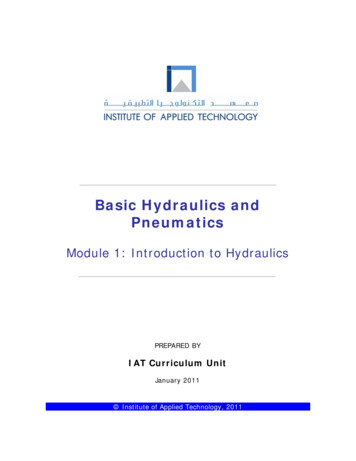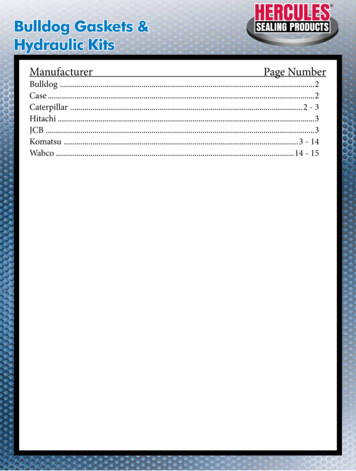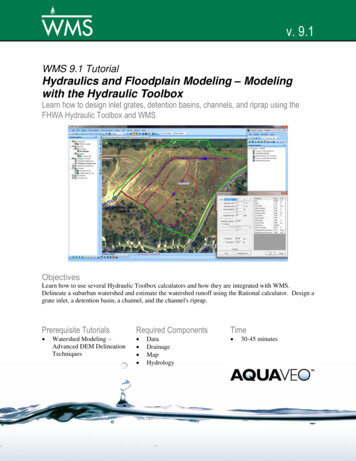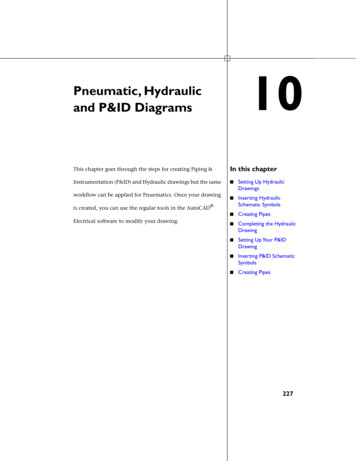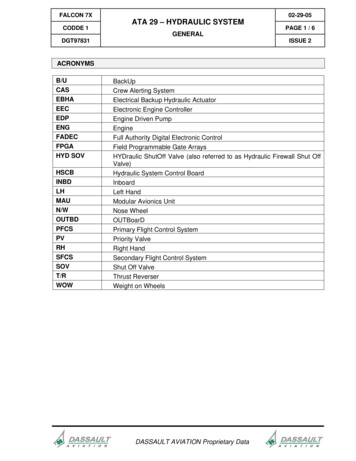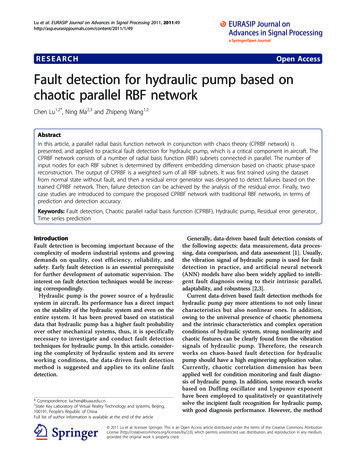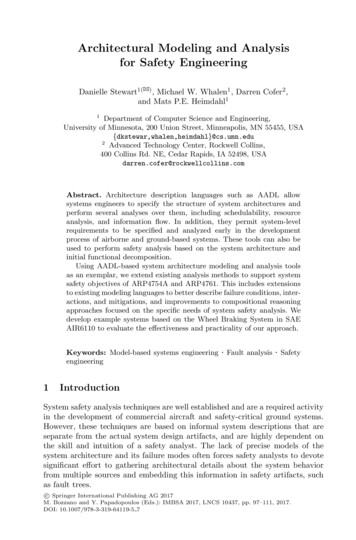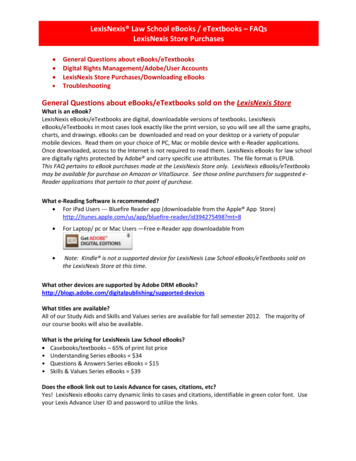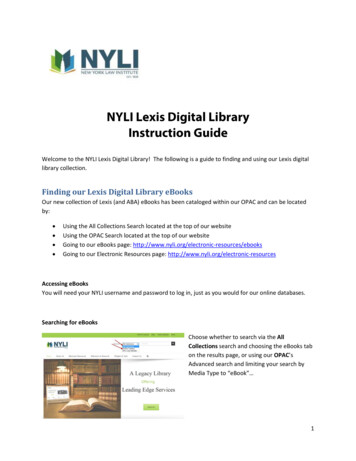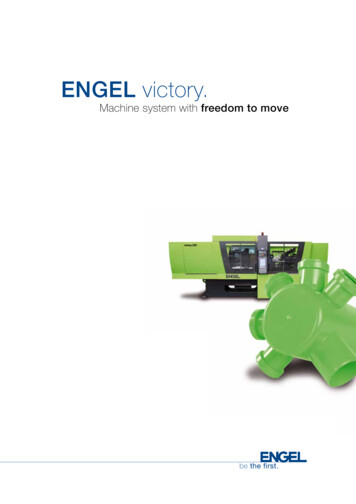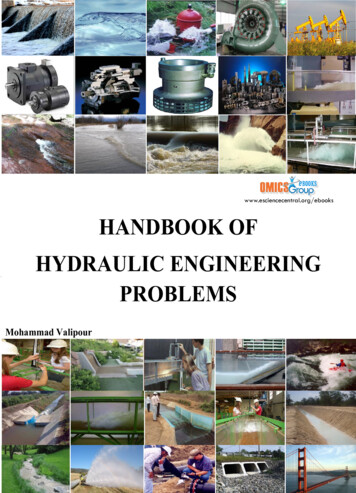
Transcription
Please site OMICSwww.esciencecentral.org/ebookslogo here.HANDBOOK OFHYDRAULIC ENGINEERINGPROBLEMSCutoff TimeMohammad ValipourSeyyed Morteza MousaviReza ValiporEhsan Rezaei
eBooksHandbook of Hydraulic Engineering ProblemsEdited by: Mohammad ValipourPublished Date: June 2014Published by OMICS Group eBooks731 Gull Ave, Foster City. CA 94404, USACopyright 2014 OMICS GroupThis eBook is an Open Access distributed under the Creative Commons Attribution 3.0license, which allows users to download, copy and build upon published articles even forcommercial purposes, as long as the author and publisher are properly credited, whichensures maximum dissemination and a wider impact of our publications. However, userswho aim to disseminate and distribute copies of this book as a whole must not seekmonetary compensation for such service (excluded OMICS Group representatives andagreed collaborations). After this work has been published by OMICS Group, authors havethe right to republish it, in whole or part, in any publication of which they are the author,and to make other personal use of the work. Any republication, referencing or personal useof the work must explicitly identify the original source.Notice:Statements and opinions expressed in the book are these of the individual contributorsand not necessarily those of the editors or publisher. No responsibility is accepted for theaccuracy of information contained in the published chapters. The publisher assumes noresponsibility for any damage or injury to persons or property arising out of the use of anymaterials, instructions, methods or ideas contained in the book.A free online edition of this book is available at www.esciencecentral.org/ebooksAdditional hard copies can be obtained from orders @ www.esciencecentral.org/ebooks
eBooksPrefaceIn near future, energy become a luxury item and water is considered as the most vitalitem in the world due to reduction of water resources in most regions. In this condition,role of water science researchers and hydraulic experts is more important than ever. If ahydraulic engineer student is not educated well, he/she will not solve problems of hydraulicsciences in future. Many engineer students learn all necessary lessons in the university,but they cannot to answer to the problems or to pass the exams because of forgetfulnessor lack of enough exercise. This book contains one hundred essential problems related tohydraulic engineering with a small volume. Undoubtedly, many problems can be added tothe book but the author tried to mention only more important problems and to preventincreasing volume of the book due to help to feature of portability of the book. To promotionof student skill, both SI and English systems have been used in the problems. All of theproblems were solved completely. This book is useful for not only exercising and passingthe university exams but also for use in actual project as a handbook. The handbook ofhydraulic engineering problems is usable for agricultural, civil, and environmental students,teachers, experts, researchers, engineers, designers, and all enthusiastic readers inhydraulic, hydrodynamic, fluid mechanics, irrigation, drainage engineering, and waterresources fields. The prerequisite to study of the book and to solve of the problems is eachappropriate book about hydraulic science; however, the author recommends studying theReferences to better understanding the problems and presented solutions. It is an honor forthe author for receive any review and suggestion to improvement of book quality.-Mohammad Valipour
eBooksAbout AuthorMohammad Valipour is a Ph.D. candidate in Agricultural Engineering-Irrigation and Drainageat Sari Agricultural Sciences and Natural Resources University, Sari, Iran. He completedhis B.Sc. Agricultural Engineering-Irrigation at Razi University, Kermanshah, Iran in 2006and M.Sc. in Agricultural Engineering-Irrigation and Drainage at University of Tehran,Tehran, Iran in 2008. Number of his publications is more than 50. His current researchinterests are surface and pressurized irrigation, drainage engineering, relationship betweenenergy and environment, agricultural water management, mathematical and computermodeling and optimization, water resources, hydrology, hydrogeology, hydro climatology,hydrometeorology, hydro informatics, hydrodynamics, hydraulics, fluid mechanics, andheat transfer in soil media.
eBooksContentsProblemsReferencesPage #170
eBooksHandbook of Hydraulic EngineeringProblemsMohammad Valipour1*Young Researchers and Elite Club, Kermanshah Branch, Islamic Azad University, Kermanshah,Iran*Corresponding author: Mohammad Valipour, Young Researchers and Elite Club, KermanshahBranch, Islamic Azad University, Kermanshah, Iran; E-mail: vali-pour@hotmail.comProblems1. The volume flow Q over a dam is proportional to dam width B and also varies withgravity g and excess water height H upstream, as shown in the figure. What is the onlypossible dimensionally homogeneous relation for this flow rate?So far we know that Q B fcn (H,g). Write this in dimensional form:Handbook of Hydraulic Engineering ProblemsEdited by: Mohammad Valipour1
eBooks L3 {Q} T , g )} { L}{ f ( H , g )}{B}{ f ( H So the function fcn (H,g) must provide dimensions of {L2/T}, but only g contains time. Thereforeg must enter in the form g1/2 to accomplish this. The relation is nowQ Bg1/2 fcn (H), or: {L3/T} {L} {L1/2/T} {fcn(H)}, or: {fcn(H)} {L3/2}In order for fcn (H) to provide dimensions of {L3/2}, the function must be a 3/2 power.Thus the final desired homogeneous relation for dam flow is:Q CBg1/2 H3/2, where C is a dimensionless constant2. A vertical clean glass piezometer tube has an inside diameter of 1 mm. When a pressureis applied, water at 20 C rises into the tube to a height of 25 cm. After correcting forsurface tension, estimate the applied pressure in Pa.For water, let Y 0.073 N/m, contact angle θ 0 , and γ 9790 N/m3. The capillary rise in thetube, from Example 1.9 of the text, is hcap2Y cosθ γR2 ( 0.073 N / m ) cos ( 0 ) 0.030 m9790 n / m3 ( 0.0005 m )()Then the rise due to applied pressure is less by that amount: hpress 0.25 m 0.03 m 0.22m. The applied pressure is estimated to be p γhpress (9790 N/m3) (0.22 m) 2160 Pa3. The deepest point in the ocean is 11034 m in the Mariana Tranch in the Pacific. Atthis depth γseawater 10520 N/m3. Estimate the absolute pressure at this depth.Seawater specific weight at the surface is 10050 N/m3. It seems quite reasonable to averagethe surface and bottom weights to predict the bottom pressure: 10050 10520 pbottom p0 γ abgh 101350 ) 1.136 E8 Pa 1121 atm (110342 4. The U-tube at right has a 1-cm ID and contains mercury as shown. If 20 cm3 of wateris poured into the right-hand leg, what will be the free surface height in each leg afterthe sloshing has died down?Handbook of Hydraulic Engineering ProblemsEdited by: Mohammad Valipour2
eBooksFirst figure the height of water added:20 cm3 π4(1 cm )2h, or h 25.46 cmThen, at equilibrium, the new system must have 25.46 cm of water on the right, and a30-cmlength of mercury is somewhat displaced so that “L” is on the right, 0.1 m on the bottom,and “0.2 L” on the left side, as shown at right. The bottom pressure is constant:patm 133100(0.2 L) patm 9790(0.2546) 133100(L), or: L 0.0906 mThus right-leg-height 9.06 25.46 34.52 cmLeft-leg-height 20.0 9.06 10.94 cm5. The cylindrical tank in the figure is being filled with 20 C water by a pump developingan exit pressure of 175 kPa. At the instant shown, the air pressure is 110 kPa and H 35 cm. The pump stops when it can no longer raise the water pressure. Estimate “H” atthat time.At the end of pumping, the bottom water pressure must be 175 kPa:pair 9790H 175000Meanwhile, assuming isothermal air compression, the final air pressure is such thatπ R 2 ( 0.75 m )pairVolold0.75 2110000 Volnew π R (1.1 m H ) 1.1 HWhere R is the tank radius. Combining these two gives a quadratic equation for H:0.75 (110000 ) 9790 H 175000, or H 2 18.98 H 11.24 01.1 HHandbook of Hydraulic Engineering ProblemsEdited by: Mohammad Valipour3
eBooksThe two roots are H 18.37 m (ridiculous) or, properly, H 0.614 m6. A vertical lock gate is 4 m wide and separates 20 C water levels of 2 m and 3 m,respectively. Find the moment about the bottom required to keep the gate stationary.On the side of the gate where the water measures 3 m, F1 acts and has an hCG of 1.5 m; on theopposite side, F2 acts with an hCG of 1 m.F1 γ hCG1A1 (9790)(1.5)(3)(4) 176,220 NF2 γ hCG2A2 (9790)(1.0)(2)(4) 78,320 NyCP1 [ (1/12)(4)(3)3 sin 90 ]/[(1.5)(4)(3)] 0.5 m; so F1 acts at 1.5 – 0.5 1.0 m above ByCP2 [ (1/12)(4)(2)3 sin 90 ]/[(1)(4)(2)] 0.333 m; F2 acts at 1.0 – 0.33 0.67 m above BTaking moments about points B (see the figure),ΣMB (176,220 N)(1.0 m) – (78,320 N)(0.667 m) 124,000 N m; Mbottom 124 kNm7. Panel ABC in the slanted side of a water tank (shown at right) is an isosceles trianglewith vertex at A and base BC 2 m. Find the water force on the panel and its line ofaction.Handbook of Hydraulic Engineering ProblemsEdited by: Mohammad Valipour4
eBooks(a) The centroid of ABC is 2/3 of the depth down, or 8/3 m from the surface. The panel area is(1/2) (2 m)(5 m) 5 m2. The water force isFABC γ hCGApanel (9790)(2.67 m)(5 m2 ) 131,000 N(b) The moment of inertia of ABC is (1/36)(2 m)(5 m)3 6.94 m4yCP Ixx sinθ /(hCGApanel ) 6.94sin(53 )/[2.67(5)] 0.417 mThe center of pressure is 3.75 m down from A, or 1.25 m up from BC.8. In the figure, the hydrostatic force F is the same on the bottom of all three containers,even though the weights of liquid above are quite different. The three bottom shapes andthe fluids are the same. This is called the hydrostatic paradox. Explain why it is true andsketch a free body of each of the liquid columns.The three free bodies are shown below. Pressure on the side-walls balances the forces. In (a),downward side-pressure components help add to a light W. In (b) side pressures are horizontal.In (c) upward side pressure helps reduce a heavy W.9. Gate AB in the figure is 5 ft wide into the paper, hinged at A, and restrained by a stopat B. Compute (a) the force on stop B; and (b) the reactions at A if h 9.5 ft.Handbook of Hydraulic Engineering ProblemsEdited by: Mohammad Valipour5
eBooksThe centroid of AB is 2.0 ft below A, hence the centroidal depth is h 2 4 7.5 ft. Then thetotal hydrostatic force on the gate isF γ hCGAgate (62.4 lbf/ft3) (7.5 ft)(20 ft2) 9360 lbfThe C.P. is below the centroid by the amountyCP3 1 5 )( 4 ) sin 90 ( I sin θ 12 xx 0.178 fthCG A( 7.5)( 20 )This is shown on the free body of the gate at right. We find force Bx with moments about A:Handbook of Hydraulic Engineering ProblemsEdited by: Mohammad Valipour6
eBooks MA Bx ( 4.0 ) ( 9360 )( 2.178 ) 0, or : Bx 5100 lbf ( to left )The reaction forces at A then follow from equilibrium of forces (with zero gate weight): F Fx 0 9360 5100 Ax , or : Ax 4260 lbf ( to left )z 0 Az Wgate Az , or : Az 0 lbf10. The tank in the figure is 2 m wide into the paper. Neglecting atmospheric pressure,find the resultant hydrostatic force on panel BC, (a) from a single formula; (b) bycomputing horizontal and vertical forces separately, in the spirit of curved surfaces.(a) The resultant force F, may be found by simply applying the hydrostatic relationF 𝛾hCGA (9790 N/m3) (3 1.5 m) (5 m 2 m) 440,550 N 441 kN(b) The horizontal force acts as though BC were vertical, thus hCG is halfway down from C andacts on the projected area of BC.FH (9790) (4.5)(3 2) 264,330 N 264 kNThe vertical force is equal to the weight of fluid above BC,FV (9790) [(3) (4) (1/2) (4) (3)] (2) 352,440 352 kNThe resultant is the same as part (a): F [(264)2 (352)2]1/2 441 kN11. In the figure, weightless cover gate AB closes a circular opening 80 cm in diameterwhen weighed down by the 200-kg mass shown. What water level h will dislodge thegate?Handbook of Hydraulic Engineering ProblemsEdited by: Mohammad Valipour7
eBooksThe centroidal depth is exactly equal to h and force F will be upward on the gate. Dislodgingoccurs when F equals the weight:()F γ hCG Agate 9790 N / m3 hπ4( 0.8)2 W ( 200 )( 9.81) NSolve for h 0.40 m12. The pressure in the air gap is 8000 Pa gage. The tank is cylindrical. Calculate thenet hydrostatic force (a) on the bottom of the tank; (b) on the cylindrical sidewall CC;and (c) on the annular plane panel BB.(a) The bottom force is simply equal to bottom pressure time’s bottom area:()pbottom pair ρ water g z 8000 Pa 9790 N / m3 ( 0.25 0.12 m ) 11622 Pa gageFCC pCCACC (10448 Pa) (π /4)[(0.36 m)2 (0.16 m)2 ] 853 N13. Gate ABC in the figure has a fixed hinge at B and is 2 m wide into the paper. If thewater level is high enough, the gate will open. Compute the depth h for which thishappens.Handbook of Hydraulic Engineering ProblemsEdited by: Mohammad Valipour8
eBooksLet H (h 1 meter) be the depth down to the level AB. The forces on AB and BC are shownin the free body at right. The moments of these forces about B are equal when the gate opens: M B H H 0 γ H ( 0.2 ) b ( 0.1) γ ( Hb ) 2 3 Or: H 0.346 m,h H 1 1.346 mThis solution is independent of both the water density and the gate width b into the paper.14. Gate AB in the figure is semicircular, hinged at B, and held by a horizontal force P atpoint A. Determine the required force P for equilibrium.Handbook of Hydraulic Engineering ProblemsEdited by: Mohammad Valipour9
eBooksThe centroid of a semi-circle is at 4R/3π 1.273 m off the bottom, as shown in the sketch atright. Thus it is 3.0 1.273 1.727 m down from the force P. The water force F isF γ hCG A ( 9790 )( 5.0 1.727 )π2( 3)2 931000 NThe line of action of F lies below the CG:( 0.10976 )( 3) sin 90 I sin θ xx 0.0935 mhCG A π 2( 5 1.727 ) ( 3) 2 4yCPThen summing moments about B yields the proper support force P:ΣMB 0 (931000) (1.273 0.0935) 3P, or: P 366000 N15. Dam ABC in the figure is 30 m wide into the paper and is concrete (SG 2.40). Findthe hydrostatic force on surface AB and its moment about C. Could this force tip thedam over? Would fluid seepage under the dam change your argument?Handbook of Hydraulic Engineering ProblemsEdited by: Mohammad Valipour10
eBooksThe centroid of surface AB is 40 m deep, and the total force on AB isF γ hCG A ( 9790 )( 40 )(100 30 )1.175 E 9 NThe line of action of this force is two-thirds of the way down along AB, or 66.67 m from A. Thisis seen either by inspection (A is at the surface) or by the usual formula:yCP3 1 30 )(100 ) sin ( 53.13 )( I sin θ12 xx 16.67 mhCG A( 40 )( 30 100 )To be added to the 50-m distance from A to the centroid, or 50 16.67 66.67 m. As shownin the figure, the line of action of F is 2.67 m to the left of a line up from C normal to AB. TheHandbook of Hydraulic Engineering ProblemsEdited by: Mohammad Valipour11
eBooksmoment of F about C is thus MC FL (1.175E9) (66.67 64.0) 3.13E9 NmThis moment is counter clockwise; hence it cannot tip over the dam. If there were seepageunder the dam, the main support force at the bottom of the dam would shift to the left ofpoint C and might indeed cause the dam to tip over.16. Panel BCD is semicircular and line BC is 8 cm below the surface. Determine (a) thehydrostatic force on the panel; and (b) the moment of this force about D.(a) The radius of BCD is 5 cm. Its centroid is at 4R/3π or 4(5 cm)/3π 2.12 cm down alongthe slant from BC to D. Then the vertical distance down to the centroid is hCG 8 cm (2.12cm) cos (53.13 ) 9.27 cm.The force is the centroidal pressure times the panel area:F γ hCGA (9790 N/m3) (0.0927 m)(π /2)(0.05 m)2 3.57 N(b) Point D is (0.05 0.0212) 0.288 cm from the centroid. The moment of F about D is thusMD (3.57 N) (0.05 m 0.0212 m) 0.103 Nm17. The cylindrical tank in the figure has a 35-cm-high cylindrical insert in the bottom.The pressure at point B is 156 kPa. Find (a) the pressure in the air space; and (b) theforce on the top of the insert. Neglect air pressure outside the tank.Handbook of Hydraulic Engineering ProblemsEdited by: Mohammad Valipour12
eBooks(a) The pressure in the air space can be found by working upwards hydrostatically from pointB:156,000 Pa (9790 N/m3) (0.35 0.26 m) pair 150000 Pa(b) The force on top of the insert is simply the pressure on the insert times the insert area:Pinsert top 156,000 Pa (9790 N/m3) (0.35 m) 152,600 PaFinsert pinsert Ainsert (152600 Pa ) π ) 1200 Ν ( 0.1 m 4 218. Gate B is 30 cm high and 60 cm wide into the paper and hinged at the top. What isthe water depth h which will first cause the gate to open?The minimum height needed to open the gate can be assessed by calculating the hydrostaticforce on each side of the gate and equating moments about the hinge. The air pressure causesa force, Fair, which acts on the gate at 0.15 m above point D.Fair (10,000 Pa) (0.3 m) (0.6 m) 1800 NSince the air pressure is uniform, Fair acts at the centroid of the gate, or 15 cm below the hinge.The force imparted by the water is simply the hydrostatic force,Fw (γ hCGA)w (9790 N/m3 )(h 0.15 m)(0.3 m)(0.6 m) 1762.2h 264.3Handbook of Hydraulic Engineering ProblemsEdited by: Mohammad Valipour13
eBooksThis force has a center of pressure at,13( 0.6 )( 0.3) ( sin 90 ) 0.0075 yCP 12 with h in meters( h 0.15)( 0.3)( 0.6 ) h 0.15Sum moments about the hinge and set equal to zero to find the minimum height:ΣMhinge 0 (1762.2h 264.3) [0.15 (0.0075/ (h 0.15))] (1800)(0.15)This is quadratic in h, but let’s simply solve by iteration: h 1.12 m19. Determine (a) the total hydrostatic force on curved surface AB in the figure and (b)its line of action. Neglect atmospheric pressure and assume unit width into the paper.The horizontal force isFH γ hCG Avert (9790 N/m3) (0.5 m)(1 1 m2 ) 4895 N at 0.667 m below B.For the cubic-shaped surface AB, the weight of water above is computed by integration:Handbook of Hydraulic Engineering ProblemsEdited by: Mohammad Valipour14
eBooks13 3 FV γ b 1 x3 dx γ b ( 9790 )(1.0 ) 7343 N4 4 0()The line of action (water centroid) of the vertical force also has to be found by integration:1xdA x dA x (1 x ) dx03 10 0.4 m31 x3 dx431 (0)The vertical force of 7343 N thus acts at 0.4 m to the right of point A, or 0.6 m to the left of B,as shown in the sketch above. The resultant hydrostatic force then isFtotal [(4895)2 (7343)2 ]1/2 8825 N acting at 56.31 down and to the right.This result is shown in the sketch at above right. The line of action of F strikes the verticalabove point A at 0.933 m above A, or 0.067 m below the water surface.20. Water at 20 C flows upward at 4 m/s in a 6-cm-diameter pipe. The pipe lengthbetween points 1 and 2 is 5 m, and point 2 is 3 m higher. A mercury manometer,connected between 1 and 2, has a reading h 135 mm, with p1 higher. (a) What is thepressure change (p1 p2)? (b) What is the head loss, in meters? (c) Is the manometerreading proportional to head loss? Explain. (d) What is the friction factor of the flow?p1 γ w h γ w h γ w Z p2N N 46000 Paor : p1 p ) 16650 293702 133100 9790 3 ( 0.135 m ) 9790 3 ( 3 m mm Handbook of Hydraulic Engineering ProblemsEdited by: Mohammad Valipour15
eBooksh f pγw z 46000 3 m 4.7 3.0 1.7 m9790 N / m3d 2gThe friction factor is f h f LV2()2 0.06 m 2 9.81 m / s 0.025(1.7 m ) 2 5 m (4 m / s)By comparing the manometer relation to the head-loss relation above, we find that:hf (γ m γ w ) hγwAnd thus head loss is proportional to manometer reading.21. Water at 20 C flows in a 9-cm-diameter pipe under fully developed conditions. Thecenterline velocity is 10 m/s. Compute (a) Q, (b) V, (c) τw, and (d) Δp for a 100-m pipelength.For water at 20 C, take ρ 998 kg/m3 and μ 0.001 kg/ms. Check Re ρVD/μ 998(10)(0.09)/0.001 900,000, surely a turbulent flow. Use the log-law: 998 ( 0.045 ) u * uctr 1 Ru * 101* ln ln 5.0, solve u 0.350 m / s B, or : * *κ ν uu0.41 0.001 Then τw ρu*2 (998) (0.350)2 122 PaV 0.85 uctr( 0.85)(10 ) 8.5 m / sQ AV (π /4) (0.09)2 (8.5) 0.054 m3/s p2τ w L 2 (122 Pa )(100 m ) 542000 PaR( 0.045 m )22. The pipe flow in the figure is driven by pressurized air in the tank. What gagepressure p1 is needed to provide a 20 C water flow rate Q 60 m3/h?Handbook of Hydraulic Engineering ProblemsEdited by: Mohammad Valipour16
eBooksFor water at 20 C, take ρ 998 kg/m3 and μ 0.001 kg/ms. Get V, Re, f:603600 8.49 m / s V2 π ( 0.05 ) 4 998 ( 8.49 )( 0.05 )Re 424000; f smooth 0.01360.001Write the energy equation between points (1) (the tank) and (2) (the open jet):2p1 020 V pipeLV2 10 80 h f , where h f fand V pipe 8.49 m / sρ g 2gρ g 2gd 2g2 8.49 ) ( 170 Solve p1 ( 998 )( 9.81) 80 10 1 0.0136 2.38 E 6 Pa2 ( 9.81) 0.05 23. A swimming pool W by Y by h deep is to be emptied by gravity through the longpipe shown in the figure. Assuming an average pipe friction factor fav and neglectingminor losses, derive a formula for the time to empty the tank from an initial level ho.With no driving pressure and negligible tank surface velocity, the energy equation can becombined with a control-volume mass conservation:V2L V2π2 ghdhh ( t ) f av, or : Qout ApipeV D 2 WYL2gD 2g4dt1 f avDWe can separate the variables and integrate for time to drain:Handbook of Hydraulic Engineering ProblemsEdited by: Mohammad Valipour17
eBooksπ4D22g1 f avLDt00h0 WY dt Clean this up to obtain : tdrain dh WY 0 s h0h(4WYπ D2)L 2ho 1 f av D g24. The small turbine in the figure extracts 400 W of power from the water flow. Both pipesare wrought iron. Compute the flow rate Q m3/h. Sketch the EGL and HGL accurately.For water, take ρ 998 kg/m3 and μ 0.001 kg/ms. For wrought iron, take ε 0.046 mm,hence ε/d1 0.046/60 0.000767 and ε/d2 0.046/40 0.00115. The energy equation, withV1 0 and p1 p2, givesHandbook of Hydraulic Engineering ProblemsEdited by: Mohammad Valipour18
eBooksz1 z2 20 m V22 h f 2 hturbine2gh f 1 f1L1 V12d1 2 ghf 2 f2L2 V22d2 2 gh turbine400WP ρ gQ 998 ( 9.81) Q Qππ d12V1d 22V244The only unknown is Q, which we may determine by iteration after an initial guess:4008 f L Q2 8 f L Q28Q 2 hturbine 20 12 1 5 22 2 5 2 4π gd1π gd 2 π gd 2998 ( 9.81) Q 0.003 m3 / s, then Re Guess Q14ρQ 63500, f1, Moody 0.0226, Re 95300, f 2 0.02282πµ d1But, for this guess, hturbine (left hand side) 13.62 m, hturbine (right hand side) 14.53 m(wrong).Other guesses converge to hturbine 9.9 meters. For Q 0.00413 m3/s 15 m3/h.25. For the parallel-pipe system of the figure, each pipe is cast iron, and the pressuredrop p1 p2 3 lbf/in2. Compute the total flow rate between 1 and 2 if the fluid is SAE10 oil at 20 C.For SAE 10 oil at 20 C, take ρ 1.69 slug/ft3 and μ 0.00217 slug/ft.s. For cast iron, ε 0.00085 ft. Convert Δp 3 psi 432 psf and guess laminar flow in each:Handbook of Hydraulic Engineering ProblemsEdited by: Mohammad Valipour19
eBooks128 ( 0.00217 )( 200 ) Qb128µ LbQb 4324π db4 2 π 12 Qb 0.0188 ft 3 / s Check Re 112 pb The total flow rate is Q Qa Qb 0.0763 0.0188 0.095 ft3 /s26. In the figure all pipes are 8-cm-diameter cast iron. Determine the flow rate fromreservoir (1) if valve C is (a) closed; and (b) open, with Kvalve 0.5.For water at 20 C, take ρ 998 kg/m3 and μ 0.001 kg/m.s. For cast iron, ε 0.26 mm, henceε/d 0.26/80 0.00325 for all three pipes. Note p1 p2, V1 V2 0. These are long pipes, butwe might wish to account for minor losses anyway:Sharp entrance at A: K1 0.5; line junction from A to B: K2 0.9Branch junction from A to C: K3 1.3; two submerged exits: KB KC 1.0If valve C is closed, we have a straight series path through A and B, with the same flow rate Q,velocity V, and friction factor f in each. The energy equation yieldsz1 z2 hfA ΣhmA hfB ΣhmB,Handbook of Hydraulic Engineering ProblemsEdited by: Mohammad Valipour20
eBooks25 mV 2 10050ε 0.5 0.9 f 1.0 f, where f fcn Re, 2 ( 9.81) 0.080.08d Guess f ffullyrough 0.027, then V 3.04 m/s, Re 998(3.04)(0.08)/(0.001) 243000,ε/d 0.00325, then f 0.0273 (converged). Then the velocity through A and B is V 3.03 m/s, and Q (π /4) (0.08)2(3.03) 0.0152 m3/s.If valve C is open, we have parallel flow through B and C, with QA QB QC and, with dconstant, VA VB VC. The total head loss is the same for paths A-B and A-C:z1 z2 hfA ΣhmA-B hfB ΣhmB hfA ΣhmA-C hfC ΣhmC25VA2 100VB2 50 1.0 f0.50.9fBA 2 ( 9.81) 0.08 2 ( 9.81) 0.08 VA2 100VC2 70 1.0 f0.51.3fCA 2 ( 9.81) 0.08 2 ( 9.81) 0.08 Plus the additional relation VA VB VC. Guess f ffully rough 0.027 for all three pipes andbegin. The initial numbers work out to 2 g ( 25 ) 490.5 VA2 (1250 f A 1.4 ) VB2 ( 625 f B 1) VA2 (1250 f A 1.8 ) VC2 ( 875 fC 1)If f 0.027, solve (laboriously) VA 3.48 m/s, VB 1.91 m/s, VC 1.57 m/sCompute Re 278000, f A 0.0272, Re 153000, f B 0.0276, Re 125000, fC 0.0278ABCRepeat once for convergence: VA 3.46 m/s, VB 1.90 m/s, VC 1.56 m/s. The flow rate fromreservoir (1) is QA (π/4) (0.08)2(3.46) 0.0174 m3/s. (14% more)27. Consider the three-reservoir system of the figure with the following data:L1 95 m L2 125 m L3 160 mz1 25 m z2 115 m z3 85 mAll pipes are 28-cm-diameter unfinished concrete (ε 1 mm). Compute the steady flowrate in all pipes for water at 20 C.Handbook of Hydraulic Engineering ProblemsEdited by: Mohammad Valipour21
eBooksFor water at 20 C, take ρ 998 kg/m3 and μ 0.001 kg/m.s. All pipes have ε/d 1/280 0.00357. Let the intersection be “a.” The head loss at “a” is desired:L1 V12z1 ha f1d1 2 gz2 ha f2z3 ha f3L2 V22d2 2 gL3 V32d3 2 gplus the requirement that Q1 Q2 Q3 0 or, for same d, V1 V2 V3 0We guess ha then iterate each friction factor to find V and Q and then check if ΣQ 0.ha 75 m : 25 75 115 752 95 V1 50 f, solve f1 0.02754, V1 10.25 m / s( )1 0.28 2 ( 9.81)2 125 V2 f2 gives f 2 0.02755. V2 7.99 0.28 2 ( 9.81) 2 160 V3 85 75 f3 0.28 2 ( 9.81) gives f3 0.02762, V3 3.53 m / s, V 1.27Repeating for ha 80 m gives V1 10.75, V2 7.47, V3 2.49 m/s, ΣV 0.79.Interpolate to ha 78 m, gives V1 10.55 m/s, V2 7.68 m/s, V3 2.95 m/s, or:Q1 0.65 m3/s, Q2 0.47 m3/s, Q3 0.18 m3/s.28. Three cast-iron pipes are laid in parallel with these dimensions:Pipe 1: L1 800 m d1 12 cmPipe 2: L2 600 m d2 8 cmHandbook of Hydraulic Engineering ProblemsEdited by: Mohammad Valipour22
eBooksPipe 3: L3 900 m d3 10 cmThe total flow rate is 200 m3/h of water at 20 C. Determine (a) the flow rate in each pipe;and (b) the pressure drop across the system.For water at 20 C, take ρ 998 kg/m3 and μ 0.001 kg/m.s. For cast iron, ε 0.26 mm. Then,ε/d1 0.00217, ε/d2 0.00325, and ε/d3 0.0026. The head losses are the same for each pipe,and the flow rates add: hf8 f1L1Q12 8 f 2 L2Q22 8 f3 L3Q32 π 2 gd15π 2 gd 25π 2 gd35200Q1 Q2 Q3 m3 / s360011 2 f1 2 f1 Substitute and combine : Q1 1 0.418 0.599 0.0556 m3 / s f2 f3 We could either go directly to EES or begin by guessing f1 f2 f3, which gives Q1 0.0275m3/s, Q2 0.0115 m3/s, and Q3 0.0165 m3/s. This is very close! Further iteration givesRe1 298000, f1 0.0245; Re2 177000, f2 0.0275; Re3 208000, f3 0.0259Q1 0.0281 m3 /s, Q2 0.0111 m3 /s , and Q3 0.0163 m3 /shf 51.4 m, Δp ρghf (998 kg/m3 )(9.81 m/s2 )(51.4 m) 503,000 Pa29. In the five-pipe horizontal network of the figure, assume that all pipes have a frictionfactor f 0.025. For the given inlet and exit flow rate of 2 ft3/s of water at 20 C,determine the flow rate and direction in all pipes. If pA 120 lbf/in2 gage, determine thepressures at points B, C, and D.For water at 20 C, take ρ 1.94 slug/ft3 and μ 2.09E 5 slug/ft.s. Each pipe has a head losswhich is known except for the square of the flow rate:Handbook of Hydraulic Engineering ProblemsEdited by: Mohammad Valipour23
eBooks28 ( 0.025 )( 3000 ) QAC8 fLQ 22 K AC QAC, where Κ AC 60.425π 2 gd 5 AC 6 2π ( 32.2 ) 12 Similarly, K AB 19.12, K BC 13.26, K CD 19.12, K BD 19.33Pipe AC : h fThere are two triangular closed loops, and the total head loss must be zero for each.Using the flow directions assumed on the figure above, we haveLoop A-B-C: 19.12Q2AB 13.26Q2BC 60.42Q2AC 0Loop B-C-D: 13.26Q2BC 19.12Q2CD 19.33Q2BD 0And there are three independent junctions which have zero net flow rates:Junction A: QAB QAC 2.0; B: QAB QBC QBD; C: QAC QBC QCDThese are five algebraic equations to be solved for the five flow rates. The answers are:QAB 1.19, QAC 0.81, QBC 0.99, QCD 1.80, QBD 0.20 ft3/sThe pressures follow by starting at A (120 psi) and subtracting off the friction losses:2pB p A ρ gK ABQAB 120 144 62.4 (19.12 )(1.19 )215590 psf 108 lbf / in 2144Similarly, pC 103 psi and pD 76 psip B30. In the figure all four horizontal cast-iron pipes are 45 m long and 8 cm in diameterand meet at junction delivering water at 20 C. The pressures are known at four pointsas shown:p1 950 kPap2 350 kPap3 675 kPap4 100 kPaNeglecting minor losses, determine the flow rate in each pipe.Handbook of Hydraulic Engineering ProblemsEdited by: Mohammad Valipour24
eBooksFor water at 20 C, take ρ 998 kg/m3 and μ 0.001 kg/m.s. All pipes are cast iron, with ε/d 0.26/80 0.00325. All pipes have L/d 45/0.08 562.5
eBooks Preface In near future, energy become a luxury item and water is considered as the most vital . hydraulics, fluid mechanics, and heat transfer in soil media. eBooks Contents Page # Problems 1 References 70. eBooks Handbook of Hydraulic Engineering Problems Edited by Mohammad Valipour 1
